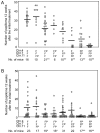Mapping of new skin tumor susceptibility loci by a phenotype-driven congenic approach
- PMID: 30405807
- PMCID: PMC6202554
- DOI: 10.3892/ol.2018.9495
Mapping of new skin tumor susceptibility loci by a phenotype-driven congenic approach
Abstract
As cancer susceptibility varies among mouse strains, mouse models are powerful tools for the identification of genes responsible for cancer development. Several cancer susceptibility loci have been mapped by genetic analysis using cancer-resistant and cancer-susceptible mouse strains. However, only a few corresponding genes for these loci have been identified, because most of the cancer susceptibility loci are low-penetrance alleles. We reported previously that wild-derived PWK mice showed no tumor development on treatment with the two-stage skin carcinogenesis protocol [induced by 7.12-dimethylbenz(a)anthracene (DMBA)/12-O-tetradecanoylphorbol-13-acetate (TPA)], and that this phenotype is dominant-resistant when crossed with the highly susceptible strain FVB. From the analysis of the F1 backcross generation between PWK and FVB, we have mapped the new significant locus Skts-fp1 on chromosome 4. In the present study, congenic strains were generated with the PWK resistance allele in the FVB background using a phenotype-driven approach, and sought to narrow down the candidate loci and find the responsible gene(s). One of the resistant mice in the N6 generation carried the remaining PWK allele on chromosomes 4, 7 and 11, and an association study using the progeny of this mouse suggested that the locus on chromosome 11 may affect the cancer susceptibility locus on chromosome 7. On the other hand, no skin tumor susceptibility locus was mapped on chromosome 11 as examined in N2 progeny. These findings suggest that there is at least one tumor-resistance gene on chromosome 7, the function of which could be regulated by gene(s) located on chromosome 11.
Keywords: cancer susceptibility; mouse model; squamous cell carcinoma; two stage skin carcinogenesis.
Figures



Similar articles
-
New chemically induced skin tumour susceptibility loci identified in a mouse backcross between FVB and dominant resistant PWK.BMC Genet. 2007 Jun 28;8:39. doi: 10.1186/1471-2156-8-39. BMC Genet. 2007. PMID: 17598916 Free PMC article.
-
New outbred colony derived from Mus musculus castaneus to identify skin tumor susceptibility loci.Mol Carcinog. 2010 Jul;49(7):653-61. doi: 10.1002/mc.20635. Mol Carcinog. 2010. PMID: 20564342 Free PMC article.
-
Congenic mapping and allele-specific alteration analysis of Stmm1 locus conferring resistance to early-stage chemically induced skin papillomas.PLoS One. 2014 May 20;9(5):e97201. doi: 10.1371/journal.pone.0097201. eCollection 2014. PLoS One. 2014. PMID: 24844776 Free PMC article.
-
Polygenic resistance to mouse pulmonary adenomas.Exp Lung Res. 2000 Dec;26(8):617-25. doi: 10.1080/01902140150216701. Exp Lung Res. 2000. PMID: 11195459 Review.
-
Genetic mapping of cancer susceptibility/resistance loci in the mouse.Recent Results Cancer Res. 1998;154:292-7. doi: 10.1007/978-3-642-46870-4_20. Recent Results Cancer Res. 1998. PMID: 10027009 Review.
Cited by
-
Nonviral CRISPR/Cas9 mutagenesis for streamlined generation of mouse lung cancer models.Proc Natl Acad Sci U S A. 2024 Jul 9;121(28):e2322917121. doi: 10.1073/pnas.2322917121. Epub 2024 Jul 3. Proc Natl Acad Sci U S A. 2024. PMID: 38959035 Free PMC article.
-
The Anti-Tumorigenic Role of Cannabinoid Receptor 2 in Non-Melanoma Skin Cancer.Int J Mol Sci. 2023 Apr 24;24(9):7773. doi: 10.3390/ijms24097773. Int J Mol Sci. 2023. PMID: 37175480 Free PMC article.
-
A wild-derived inbred mouse strain, MSM/Ms, provides insights into novel skin tumor susceptibility genes.Exp Anim. 2021 Aug 6;70(3):272-283. doi: 10.1538/expanim.21-0017. Epub 2021 Mar 26. Exp Anim. 2021. PMID: 33776021 Free PMC article.
-
Differential Hairless Mouse Strain-Specific Susceptibility to Skin Cancer and Sunburn.J Invest Dermatol. 2019 Aug;139(8):1837-1840.e3. doi: 10.1016/j.jid.2019.01.028. Epub 2019 Feb 8. J Invest Dermatol. 2019. PMID: 30742806 Free PMC article. No abstract available.
References
-
- Bangrazi C, Mouton D, Neveu T, Saran A, Covelli V, Doria G, Biozzi G. Genetics of chemical carcinogenesis. 1. Bidirectional selective breeding of susceptible and resistant lines of mice to two-stage skin carcinogenesis. Carcinogenesis. 1990;11:1711–1719. doi: 10.1093/carcin/11.10.1711. - DOI - PubMed
LinkOut - more resources
Full Text Sources
Molecular Biology Databases
Research Materials
